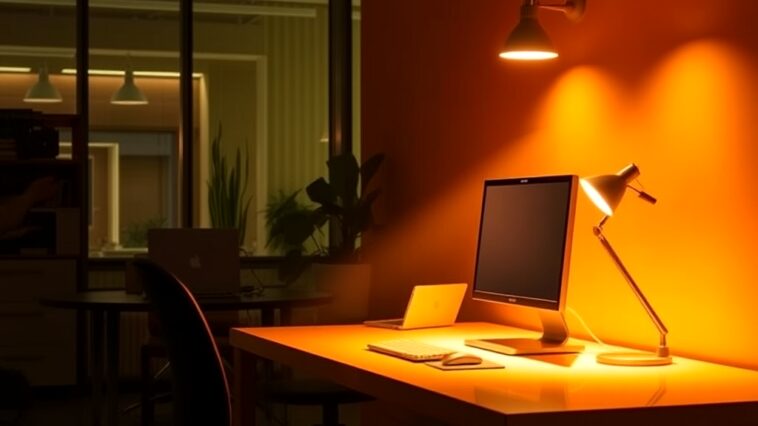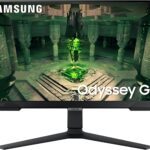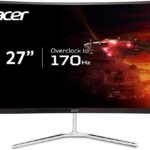In today’s digital age, many of us spend hours in front of computer monitors, whether for work or leisure. This prolonged exposure can lead to discomfort and visual strain, making glare control an essential consideration when choosing lighting solutions for our workspaces. So, which luminaire feature provides glare control while using computer monitors? Let’s explore this topic in depth.
The Importance of Glare Control in Office Luminaires for Computer Use
When you’re working on a computer, the last thing you want is distracting glare bouncing off your screen. Glare control is vital not only for comfort but also for productivity. Excessive glare can lead to headaches, eye strain, and reduced concentration. Therefore, understanding the features of luminaires that help minimize glare from monitors is crucial.
How Luminaire Design Impacts Glare Control for Computer Users
The design of a luminaire can significantly influence its ability to control glare. Luminaires with a well-thought-out design will often incorporate features that reflect or diffuse light in a way that reduces direct glare. For instance, fixtures with soft edges or angled reflectors can help redirect light away from screens.
Features of Luminaires That Help Minimize Glare from Monitors
- Diffusers: Many luminaires come with diffusers that soften the light and spread it evenly across a room. This helps to eliminate harsh shadows and reduces the intensity of the light hitting your monitor.
- Adjustable Brightness: Luminaires with adjustable brightness settings allow you to control the light output based on your specific needs. This feature is particularly beneficial when you’re working in varying light conditions.
- Anti-Glare Technology: Some luminaires are equipped with anti-glare features, such as specialized lenses that filter out harsh light and minimize reflections. This technology can vastly improve screen visibility.
- Positioning and Angling: The ability to adjust the position of the luminaire can also play a role in glare control. By angling the light source away from the monitor, you can effectively reduce glare while maintaining adequate illumination for your workspace.
Best Luminaires for Glare Control When Working on Computer Screens
Choosing the right luminaire can transform your workspace into a more comfortable environment. Here are some of the best luminaires for glare control when working on computer screens:
- LED Panel Lights: These fixtures provide even illumination and are often designed with anti-glare features. Their slim profile makes them perfect for modern offices.
- Task Lighting: Adjustable desk lamps that offer focused light can help reduce glare on your computer screen. Look for models with diffusers and adjustable brightness.
- Indirect Lighting: Fixtures that bounce light off walls or ceilings can create a soft, ambient glow that is less likely to cause glare compared to direct lighting.
How to Choose Luminaires That Reduce Glare for Office Lighting
When selecting luminaires for your workspace, consider the following factors:
- Light Color Temperature: Warmer color temperatures (around 3000K) tend to be softer on the eyes compared to cooler temperatures (above 4000K).
- Luminaire Height and Placement: Make sure your luminaires are positioned correctly. Higher placement can reduce the chance of glare.
- Brightness Levels: Choose luminaires that allow you to adjust brightness levels to match your working conditions.
Top-Rated Luminaires for Preventing Glare While Using Laptops
If you’re using a laptop, glare can often be more pronounced due to the reflective screens. Here are some top-rated luminaires for preventing glare while using laptops:
- BenQ ScreenBar: An innovative lamp that sits atop your monitor, providing direct light to your keyboard while minimizing glare on the screen.
- TaoTronics LED Desk Lamp: This lamp features adjustable brightness and color temperatures, making it perfect for reducing glare while you work.
- Philips Hue White Ambiance: Smart lighting that allows you to change the brightness and warmth of the light, helping to reduce glare effectively.
Best Lighting Solutions for Reducing Monitor Glare in Home Offices
Home offices require flexible lighting solutions that cater to individual needs. Here are some best lighting solutions for reducing monitor glare in home offices:
- Smart LED Bulbs: These can adjust brightness and color temperature automatically based on the time of day, helping to prevent glare and eye strain.
- Wall-mounted Sconces: Properly angled wall sconces can provide ambient light without creating sharp reflections on your screen.
- Floor Lamps with Adjustable Heads: These versatile fixtures can be repositioned as needed to avoid glare from your monitor.
Comparing Glare Control Features in Different Types of Office Luminaires
Not all luminaires are created equal, particularly when it comes to glare control. Here’s how to compare glare control features in different types of office luminaires:
| Luminaire Type | Glare Control Features | Pros | Cons |
|———————|———————————————————-|————————————–|—————————————–|
| LED Panels | Diffusers, low brightness | Even light distribution | Installation can be complex |
| Desk Lamps | Adjustable brightness, anti-glare lenses | Portable, focused light | Limited coverage area |
| Overhead Fixtures | Indirect lighting, soft diffusers | Wide coverage | May require ceiling installation |
| Smart Lighting | Customizable brightness and color temperature | Flexible options | May be more expensive |
Luminaires with Adjustable Brightness for Computer Screen Glare Reduction
Having the ability to adjust brightness is a game-changer for glare control. Luminaires with adjustable brightness for computer screen glare reduction allow you to customize the lighting according to your activities. For example, you might prefer brighter light while reading documents but softer light when working on your laptop.
The Role of Personal Preferences in Choosing Luminaires
Everyone has different preferences when it comes to lighting. Some may prefer bright, stimulating light, while others might opt for softer, warmer tones. Finding the right combination of light features that suit your personal style can greatly enhance your workspace’s comfort.
Conclusion: A Balanced Approach to Glare Control
In conclusion, selecting the right luminaire for glare control while using computer monitors involves understanding the various features that contribute to a comfortable working environment. By considering factors such as diffusers, brightness adjustments, and luminaire design, you can create a workspace that minimizes glare and enhances productivity.
Remember, the best approach is to combine various types of lighting solutions to achieve the ideal balance for your unique needs. With the right luminaires, you’ll love how your workspace transforms into a haven of comfort and efficiency, allowing you to focus on what truly matters—your work.
Top 10 FAQs About Luminaire Features for Glare Control While Using Computer Monitors
1. What is glare, and why is it a problem when working on computers?
Glare occurs when bright light interferes with your vision, causing discomfort and making it difficult to see your screen. It can lead to eye strain, headaches, and decreased productivity. You’ll love how addressing glare can make your work environment much more comfortable!
2. Which luminaire features help reduce glare?
The best luminaire features for glare control include diffusers, reflectors, and adjustable brightness levels. These elements help to soften the light, spread it evenly, and minimize direct light hitting your eyes. Using fixtures with these features can make a significant difference in your daily comfort.
3. How does the angle of light impact glare?
The angle at which light hits your screen can create reflections that cause glare. Ideally, you want the light source to be positioned above and behind you. This way, it illuminates your workspace without shining directly into your eyes or reflecting on your screen.
4. Are LED lights good for glare control?
Yes, LED lights can be excellent for glare control. Look for LED fixtures with adjustable color temperatures and dimming options. Warmer light hues can be easier on the eyes, especially during long hours in front of a screen. You’ll appreciate how customizable these options are!
5. How important is the color temperature of a luminaire?
Color temperature plays a crucial role in reducing glare. Cooler temperatures (above 4000K) can create more glare, while warmer tones (below 3000K) tend to be softer and more comfortable for eye health. In my experience, finding the right balance can make long work sessions much more enjoyable.
6. What role do window coverings play in glare control?
Window coverings, like blinds or shades, can significantly help control natural light and reduce glare on your computer screen. Angle your blinds to filter light effectively, or use blackout curtains during bright days. You’ll find that simple adjustments can lead to big improvements!
7. Can I use task lighting to reduce glare?
Absolutely! Task lighting can help focus light on specific areas without adding to the overall brightness of the room. Use adjustable desk lamps with diffusers to direct light where you need it most, minimizing the chance of glare on your monitor.
8. How often should I change my lighting setup?
It’s a good idea to reassess your lighting setup every few months or whenever you notice discomfort. Changes in your work habits, new equipment, or even seasonal shifts can all affect how light interacts with your space. Don’t hesitate to experiment until you find what works best for you!
9. Are there specific products designed for glare control?
Yes, many manufacturers offer luminaires specifically designed to reduce glare. Look for products labeled as “anti-glare” or “glare-free.” These often include features like frosted glass or specialized optics to ensure light is diffused properly.
10. What are some quick fixes for glare I can try right now?
Here are a few quick fixes:
- Adjust your screen brightness to match the room’s light.
- Reposition your monitor to avoid direct light.
- Use a screen filter that reduces glare.
- Experiment with different desk positions until you find the best angle.
Implementing these tips can greatly improve your comfort while working on a computer, allowing you to focus on what matters most!




